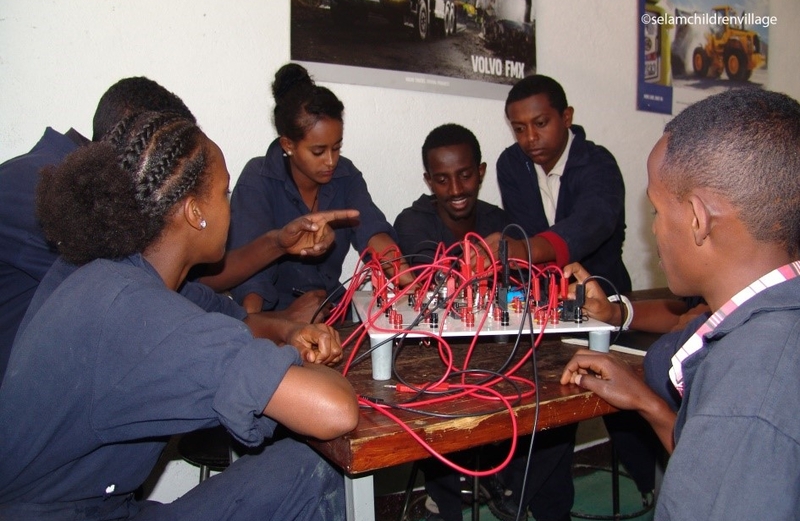Connecting Major Stakeholders to increase the employment rate of youth: Selam Children’s Village/Selam TEVET College


Institution: Selam Children's Village/ Selam TEVET College
Despite considerable efforts made by the government and non-government organizations, youth unemployment is still a significant challenge of Ethiopia and Addis Ababa in particular. TVETs and industries are important actors in the government's response to the need to create job opportunities for its growing labor force. Each year, many young graduates enroll in vocational training institutions in Ethiopia at different levels. However, many graduates from TVETs do not find employment in their area of training fields.
In response to this, Selam TVET college has been implementing a project called “Employable Youth in Ethiopia (EYE)” since June 2017. The EYE project aims to contribute to increased employability of male and female youth in Ethiopia for a better future, and it is implemented with the financial and technical support of Woord en Daad, a Dutch Christian development NGO. The project is implemented in two sub-cities of Addis Ababa, Yeka, and Bole. The direct beneficiaries of the project are unemployed youth, and the major stakeholders are the youth, Selam TVET College, industries, and companies, Micro Finance Institutions (MFIs).
The approach used for the EYE Project is the Job and Business Service (JBS) model, which actively links the main actors of the youth training and employment. Through this approach, all the major actors: the youth, the training provider (Selam TVET College), employers, and other key stakeholders are connected to meet the project objective. The JBS approach was developed by Woord en Daad and Selam TVET College has adopted and successfully implemented it.
A number of stakeholders are involved in the implementation of this approach, namely:
- Job seekers (Tvet graduates/youth)
- Employers (Industry and companies)
- Government facilitators (Sub-city social and labour affairs offices and Micro and small enterprise offices.
- Financial sources (Micro-finance institutions)
The JBS model has an established unit within the TVET college system. Its main activities include: networking with industries, linking the TVET College with companies for the placement of trainees and graduates, providing information about jobs to job seekers, collecting and sharing information about the functioning of graduates in the workplace. Furthermore, the unit provides feedback to TVET College and making recommendations on opportunities to improve the training. This further allows the College to develop new training based on the identified industry needs. Furthermore, the JBS unit also links youth who would instead take the route of self-employment to Business Development Services (BDS). Financial and business development support is given to young men and women who want to start income-generating businesses individually or in groups. The JBS Office provides updated information, links the youth with the Micro and Small Enterprise Offices, provides support in establishing their working groups, Saving and Credit Associations, and legalization of these Associations.
Also, through a Digital Employment Tracking System (ETS), job placement data is collected, analysed, and segregated on gender. This information is fed into the multi-stakeholder partnership forums and government actors, which informs them of the functioning of graduates on the labour market at least once a year.
The following significant results have been observed, among others:
-
Cooperative training (apprenticeship) opportunities have been created for trainees to get hands-on practical training.
-
The College has signed MOU’s with 49 companies to provide cooperative training and recruiting graduate youth for employment.
-
Out of the total 1432 graduates, 1233 (544 Male and 689 Female) have become employed, which is 86% achievement. The students are placed mostly in private companies, to mention a few: Majestic Furniture, Shenpise Garment Factory, Coca-Cola Company, Syntec Ethiopia Private Limited Company, and 2NR Solomon Furniture
-
545 graduates (132 M and 413 Female) ventured into self-employment
-
Due to the digital employment tracking system/ETS, TVET College has shown a significant improvement in keeping records on the employment of graduates.
-
The JBS approach enabled the College to adjust its curriculum to meet industry needs.
LESSONS LEARNT
-
This experience has shown that connecting the major stakeholders, the youth, industries, training providers, MFIs, and government facilitators, is highly instrumental in increasing the relevance of skills training, maximizing job placement rates, and making TVET demand-driven.
-
The TVET sector should work not only in equipping youths with customized technical skills but also actively connecting graduates with employers and other relevant stakeholders. Job placement service is one of the critical priorities given to assure their employability after graduation.
-
Keeping records on the employment of graduates is essential to training providers to have clear information about the status of the youth after graduation. So that they can measure and identify the outcomes/impacts of their intervention.
-
Matching the skills of the trainees to the needs of the labor market using the feedbacks of JBS is instrumental in enhancing the job placement rate of TVET graduates.
ELEMENTS FOR REPLICATION
- Establishing the JBS model within a TVET College system to connect the major stakeholders
- Assigning qualified and experienced personnel/JBS officers with clear duties and responsibilities.
- Build the capacities of the JBS officers through intensive training
- Make use of the digital Employment Tracking system (ETS); collect and analyse statistics about the placement of graduates over the years, per trade, and per gender.
- Use the recommendations made by the JBS and improve training or develop new training based on industry demands. Tune the curricula with changing market demands.
Connect
For more information about this project, contact:
Ashenafi Shiberu
Manager, Planning, and Communications
Phone: +251911600459
Email: Ashenafi.shiberu@gmail.com
Addis Ababa, Ethiopia

